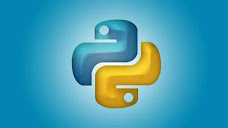Know About python
Welcome back to another article...here we will try to know some basic things about python.
Python is a high-level, versatile, and dynamically-typed programming language that was first released in 1991 by Guido van Rossum. It has gained widespread popularity due to its clean and readable syntax, making it easy to learn and use. Python supports multiple programming paradigms, including procedural, object-oriented, and functional programming.
Here are some key features and aspects of Python:
1. Readable and Clean Syntax:- Python's syntax is designed to be easy to read and write, which helps in reducing the cost of program maintenance and development. It uses indentation (whitespace) to define code blocks, which makes the code structure visually clear.
2. Cross-Platform:- Python is platform-independent, meaning you can write code on one platform (e.g., Windows) and run it on another (e.g., Linux) with little to no modification.
3. Large Standard Library:- Python comes with a vast standard library that provides modules and functions for a wide range of tasks, from handling files and networking to web development and data analysis. This reduces the need to write code from scratch for common tasks.
4. Third-Party Libraries:- Python has a rich ecosystem of third-party libraries and frameworks that extend its capabilities. For example, NumPy and pandas are popular for scientific computing and data analysis, Django and Flask for web development, and TensorFlow and PyTorch for machine learning.
5. Dynamic Typing:- Python is dynamically typed, meaning you don't need to declare the data type of a variable explicitly. The type of a variable is determined at runtime.
6. Interpreted Language:- Python is an interpreted language, which means that you don't need to compile your code before running it. This allows for quick development and testing.
7. Object-Oriented:- Python supports object-oriented programming (OOP) principles, allowing you to define classes and create objects with properties and methods.
8. Community and Resources:- Python has a large and active community of developers, which means you can find plenty of resources, tutorials, and support online. The official Python website (python.org) is a great starting point.
9. Versatility:- Python can be used for a wide range of applications, including web development, scientific computing, data analysis, machine learning, artificial intelligence, scripting, automation, and more.
10. Open Source:- Python is open-source, which means it's freely available for anyone to use, modify, and distribute.
To start using Python, you need to install the Python interpreter on your computer. You can download the latest version from the official Python website. Once installed, you can write and execute Python code using a text editor or integrated development environment (IDE).
Here's a simple example of a Python program that prints "Hello, World!":
This is just a brief overview of Python's features and characteristics. If you're interested in learning more, there are numerous online tutorials and resources available to help you get started with Python programming.




Comments
Post a Comment